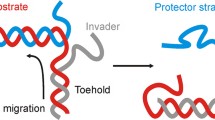Abstract
Biomolecular computing using the artificial nucleic acid technology is expected to bring new solutions to various health problems. We focus on the noninvasive transcriptome diagnosis by salivary mRNAs and present the novel concept of transcription-based diagnostic automata that are constructed by programmed DNA modules. The main computational element has a stem shaped promoter region and a pseudo-loop shaped read-only memory region for transcription regulation through the conformation change caused by targets. Our system quantifies targets by transcription of malachite green aptamer sequence triggered by the target recognition. This algorithm makes it possible to realize the cost-effective and sequence-specific real-time target detection. Moreover, in the in-vivo therapeutic use, this transcription-based system can release RNA-aptamer drugs multiply at the transcription stage, different from the digestion-based systems by the restriction enzyme which was proposed previously. We verified the sensitivity, the selectivity and the quantitative stability of the diagnostic automata in basic conditions. Our approach will provide promising applications of autonomous intelligent systems using programmed molecules.















Similar content being viewed by others
References
Babendure JR, Adams SR, Tsien RY (2003) Aptamers switch on fluorescence of triphenylmethane dyes. J Am Chem Soc 125(48):14716–14717
Baugh C, Grate D, Wilson C (2000) 2.8 Å crystal structure of the malachite green aptamer. J Mol Biol 301(1):117–128
Benenson Y, Paz-Elizur T, Adar R, Keinan E, Livneh Z, Shapiro E (2001) Programmable and autonomous computing machine made of biomolecules. Nature 414:430–434
Benenson Y, Gil Ben-Dor U, Adar R, Shapiro E (2004) An autonomous molecular computer for logical control of gene expression. Nature 429:423–429
Braich RS, Chelyapov N, Johnson C, Rothemund PWK, Adleman L (2002) Solution of a 20-variable 3-SAT problem on a DNA computer. Science 296:499–502
Bunka DHJ, Stockley PG (2006) Aptamers come of age—at last. Nat Rev Microbiol 4:588–596
De Silva AP, McClenaghan ND (2004) Molecular-scale logic gates. Chemistry 10:574–586
Famulok M (2004) Chemical biology: green fluorescent RNA. Nature 430(7003):976–977
Ginzinger DG (2002) Gene quantification using real-time quantitative PCR: an emerging technology hits the mainstream. Exp Hematol 30:503–512
Grate D, Wilson C (1999) Laser-mediated, site-specific inactivation of RNA transcripts. Proc Natl Acad Sci USA 96(11):6131–6136
Hirabayashi M, Taira S, Kobayashi S, Konishi K, Katoh K, Hiratsuka Y, Kodaka M, Uyeda TQP, Yumoto N, Kubo T (2006) Malachite green-conjugated microtubules as mobile bioprobes selective for malachite green aptamers with capturing/releasing ability. Biotechnol Bioeng 94(3):473–480
Kolpashchikov DM, Stojanovic MN (2005) Boolean control of aptamer binding states. J Am Chem Soc 127:11348–11351
Li Y, John MARSt, Zhou X, Kim Y, Sinha U, Jordan RCK, Eisele D, Abemayor E, Elashoff D, Park N-H, Wong DT (2004) Salivary transcriptome diagnostics for oral cancer detection. Clin Cancer Res 10:8442–8450
Okamoto A, Tanaka K, Saito I (2004) DNA logic gates. J Am Chem Soc 126:9458–9463
Saghatelian A, Voelcker NH, Guckian KM, Lin VS-Y, Ghadiri MR (2003) DNA-based photonic logic gates: AND, NAND, and INHIBIT. J Am Chem Soc 125:346–347
Stojanovic MN, Kolpashchikov DM (2004) Modular aptameric sensors. J Am Chem Soc 126(30):9266–9270
Wang H, Hall JG, Liu Q, Smith LM (2001) A DNA computing readout operation based on structure-specific cleavage. Nat Biotechnol 19:1053–1059
Winfree E, Liu FR, Wenzler LA, Seeman NC (1998) Design and self-assembly of two-dimensional DNA crystals. Nature 394:539–544
Author information
Authors and Affiliations
Corresponding author
Rights and permissions
About this article
Cite this article
Hirabayashi, M., Ohashi, H. & Kubo, T. Experimental analysis of the basic idea on the transcription-based diagnostic automata controlled by programmed molecules. Nat Comput 7, 403–421 (2008). https://doi.org/10.1007/s11047-008-9069-9
Received:
Accepted:
Published:
Issue Date:
DOI: https://doi.org/10.1007/s11047-008-9069-9




